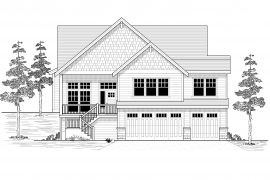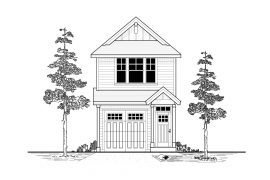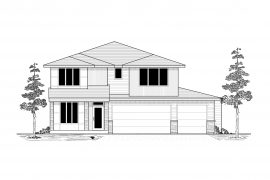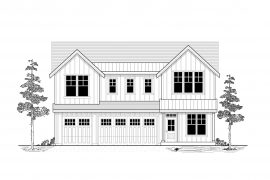Well built, well designed (skinny) homes
BY: ADRIAN MCCARTHY, HBA STAFF WRITER
 During the 2019 Oregon legislative session, lawmakers passed SB 534 – Residential Narrow Lot Development that creates more opportunities for narrow lot, skinny house development than had been previously allowed. With the new rules taking effect on March 1, 2020, Port land area homebuilders – like Fish Construction and Renaissance Homes – are looking forward to building homes on the estimated 14,000 legally platted “skinny” lots in Portland.
During the 2019 Oregon legislative session, lawmakers passed SB 534 – Residential Narrow Lot Development that creates more opportunities for narrow lot, skinny house development than had been previously allowed. With the new rules taking effect on March 1, 2020, Port land area homebuilders – like Fish Construction and Renaissance Homes – are looking forward to building homes on the estimated 14,000 legally platted “skinny” lots in Portland.
And while the legislation provides some new opportunities in the skinny house market, builders like Fish and Renaissance have spent decades refining and improving the design and quality of these homes. We sat down with Justin Wood of Fish Construction and Jeff Schrope of Renaissance Homes to learn more.
Land cost is a large contributing factor to housing cost. What else helps minimize costs and increase affordability on a skinny lot other than just cutting the land price in half?
Justin: Land cost is cheaper for sure on skinny lots but it is not half. Generally, it has been my experience that in my price range the skinny lots tend to be about 25% less on average than a SO-wide lot. This for sure is one of the major points that helps to keep these homes affordable. Additionally, the fact that we are generally constrained by size, it is harder to get more than about 1 500 – 1600 SF on one of these skinny lots so we are naturally building smaller homes than we could otherwise build on a larger lot. Further, the City of Portland has programs in place to waive SDC’s and discount property taxes (tax abatement) when we sell a home for less than the median home price for our area and to a family making less than the median family income. Because of the lot prices and sizes mentioned above, skinny homes I have found are about the last home we can build and sell and stay under the price cap (which is $395,000 now).
Can you split any SK lot into two 2500 lots? Or does the legislation only apply to historically Platted 2500 lots? Are there additional lots this might apply on other than 5k lots? For instance, when looking at an SK lot, building 3 homes instead of one?
Jeff: Generally speaking, you cannot split a SK lot into two 2500 sf lots; however, there are special circumstances where you can. For the most part, if you have a SK lot it’s a SK lot. Depending on zoning and how much property you have, you can split lots into 2, 3 or more lots.
Justin: The majority of the skinny lots in Portland are in what is called an RS zone. This is designated that lots on HBApdx.org September 2019 HBA HOME BUILDING NEW average should be around 1 home per every 5,000 sf. In the RS zone you cannot split a single 5,000 sf lot into two 2,500 lots. However, If the lot has two underlying legally platted skinny lots then you can build two on it. In the R2 .5 zone it’s more straightforward – you can split one 5,000 sf lot into two 2,500 skinny lots, because the zoning already allows for it.
The design of skinny homes has improved over the last decade or so, preempted by a design competition by the City of Portland. Even though there were some unordinary concepts that emerged from the competition, what was positive that came out of that competition? What are other builder-driven design elements that emerged from skinny home builders like yourself?
Justin: I think the main thing that has changed is that we have really had to work to improve the front facade of the home. The garage used to stick out quite a bit from the front of the home and it really dominated the facade. We have had to move the garages back, improve the front porches, add more design elements to the front bedroom as well as second floor windows. If you look at a skinny home from 10 to 15 years ago to now, you will see how much the front facing the street has improved with design quality. As for the competition, I think some good ideas about layout and flow of the home came out of it, I think all of us took away some interesting ideas that we had not otherwise considered. I don’t think any of the plans that were a part of the competition remain in use today because they were cost prohibitive compared to other plans we have.
What is your perception of neighborhood response after a good product has been built?
Jeff: We usually get a good response from the neighbors once the homes are built. We try to fit into the neighborhoods the best we can but you cannot make everyone happy because not everyone wants you there. Justin: The majority of time, I think neighbors ultimately accept the new homes in their neighborhood and think they add to the quality of the neighborhood. When we have a neighbor who is upset, we try to tell them the benefits that our home brings. Generally, we are providing an affordable new home and housing to a region that desperately needs it without creating sprawl – most of the neighbors, while they don’t want to see their street change, accept this point.
What are the considerations of on street parking vs off street parking?
Jeff: All our skinny homes have a one car garage and one parking space in the driveway. For the one car space we are removing from the street, we are adding a total of two spaces. We believe buyers want a garage. Justin: I agree. I personally prefer a driveway – but from my understanding the city might move toward to not allowing garages on these types of homes. Stay tuned.
In a skinny house, what design details become more challenging (i.e., window placements, staircase, flow, etc.)? What are the tradeoffs? And benefits?
Jeff: All the above become challenging. There are only so many ways you can design a skinny home. The HBApdx.org September 2019 HBA HOME BUILDING NEWS tradeoffs are a home buyer can get a home in a location that they traditionally might not be able to afford. Also, some people don’t want a large home or less landscaping. These homes can live easier because of the size and that fits a segment of the population. Justin: It is hard with a skinny home to really differentiate your home from a lot of others because when you add in some of the required elements into a 15′ wide home, you really end up with very much the same size and number of rooms. It is important to try and maximize every inch of space and to try and add design touches where you can to set you home apart. For example, we have figured out how to have a nice sized master bedroom with a master bath and walk-in closet. Many plans do not have a walk in closet and I think this is something that sets our plans apart.
If you were already building on these lots in Portland, why was this legislation needed and what challenges could still arise?
Justin: The City of Portland has a Residential Infill Project (RIP) in place that is examining all kinds of housing types and regulations. Currently, the proposals in the draft form of RIP recognize these skinny lots but were recommending new restrictions on what type and size of houses could be built on them. Of more concern is the fact that some on the City Council were wanting to override the RIP recommendations and stop allowing any development on skinny lots except for ones in an R2 or R2.5 zone. This would have impacted thousands of lots and further hurt our ability to build more affordably priced homes in the City. Jeff: With the new legislation, I’m curious to see what the reaction is from the City of Portland. Just because the bill allows building on these tax lots doesn’t mean the City will allow the type of building that the people of the City need. It could be that the city requires these lots be built attached and not allow the market to dictate what is needed.





